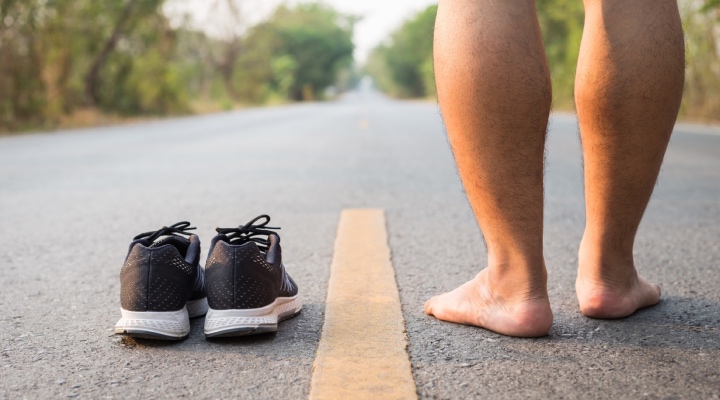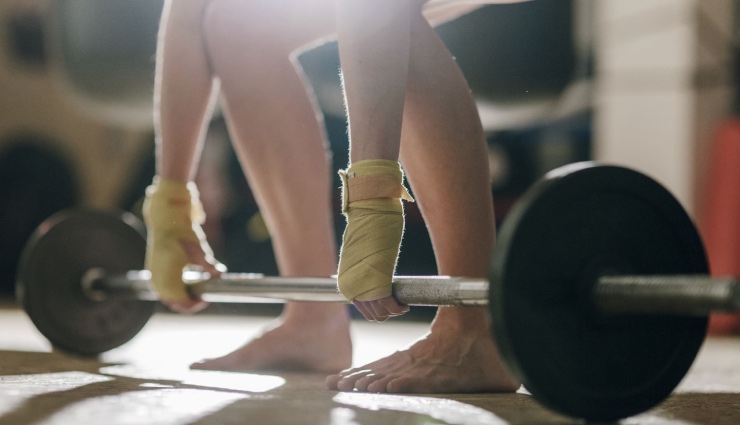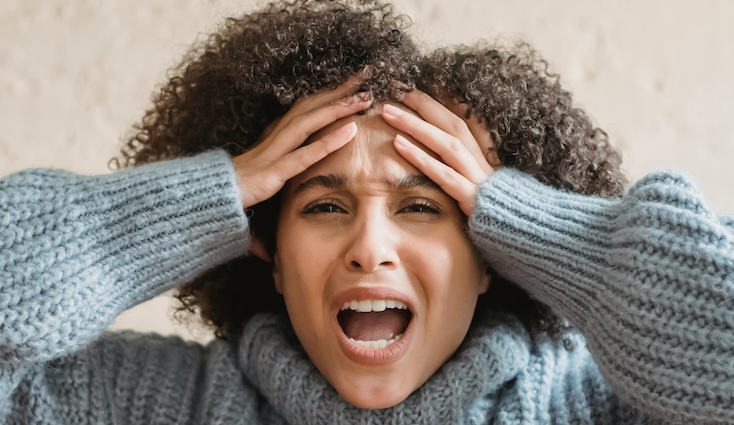Which method do you think is correct? Researchers have researched this field extensively and examined the advantages and disadvantages of exercising without shoes. Follow us in this article to see if we should wear shoes while exercising.
The benefits of exercising without shoes
Today, exercising without shoes has become more common than before. Health experts and sports trainers say exercising without shoes benefits the human body and feet. According to research, if you exercise without shoes but correctly and consciously, the pains caused by repetitive movements are reduced, and the spinal arch is corrected. Exercising without shoes may be a little tiring and risky for beginners. At first, it is better to start with short walks and simple movements and warm up the legs before training. Next, we review the most important benefits of exercising without shoes.
1. Stability
Exercising without shoes increases stability in the legs and body. When you exercise with bare feet, you can spread your toes. As a result, the contact surface of your foot with the ground will increase, and you will have more stability. Exercising with bare feet also improves the condition of your feet and toes. Exercising without shoes will correct their shape if your toes have been deformed over time due to wearing ill-fitting shoes.
2. Increased coordination
Being barefoot is a natural part of human existence. Sports experts say that returning to this natural way makes us relearn our accurate movement patterns. As a result, the way our muscles engage improves. Over time, the deep sensory receptors of our body will be activated, and we will have more coordination, stability, and balance. According to research, the more balanced our body is, the lower the risk of joint damage.
3. Leg strengthening
When you exercise with bare feet, all the muscles in your feet are engaged, but when you’re wearing sneakers, that’s not the case. Sports shoes are designed for different purposes; for example, running shoes are designed to help you move and not affect your body balance, so the muscles of your fingers and soles are not involved, and the pressure on the joints increases over time. This pressure makes your legs weak and vulnerable.
4. Increase leg mobility
Exercising without shoes improves toe movement and ankle mobility. Most people exercise in shoes, but experts aren’t sure if shoes are essential to health. According to research, shoes have many benefits, but over time, they weaken the feet with unnatural weight distribution. When you exercise without shoes, all the muscles are involved, the ligaments of the foot are activated, and the balance of the body is maintained. As a result, the mobility and dynamism of the foot increases.
5. Sensory awareness
One of the benefits of shoeless exercise is sensory feedback. When your feet are directly on the ground, your brain becomes more alert and gives instructions to the body. The brain regulates how the foot is placed on the ground and the amount of pressure. When we wear shoes, the brain does not receive a direct sensation or give an order to the body, so the pressure on the feet is not adjusted, and the joints are damaged over time.
When should we exercise without shoes?
Exercising with or without shoes depends on your taste and conditions. Of course, experts recommend wearing shoes in sports such as climbing and rock climbing is better. In addition, if you are new to the field and do not know the movements well, it is better not to take off your shoes. In jumping movements, wearing special shoes to protect the joints is good.
Some clubs do not allow sports without shoes because the club’s environment is contaminated, and the possibility of disease transmission will increase. If you exercise in a public and crowded gym, you should take the potential risks seriously and avoid exercising without shoes.
Is it allowed to run on a treadmill without shoes?

Sports experts say wearing shoes while exercising on a treadmill is better. One of the most important reasons for this advice is hygiene. Next, we will examine the advantages and disadvantages of running on a treadmill without shoes. However, if you exercise on the treadmill without shoes, start at a deficient speed to allow your body and mind to adjust. Over time, you can increase the speed and intensity of your training.
Benefits of running on a treadmill without shoes
Running without shoes corrects the natural form of your movements. When you run barefoot, your body puts pressure on the front part of the foot, and the impact and pressure are not transferred to the heel. As a result, it reduces the force on the joints and prevents possible injuries.
When you run barefoot on a treadmill, your calf and sole muscles are strengthened. Sports shoes hide the weaknesses and imbalances of your feet, but when you run without shoes, these problems are apparent, and the muscles must work harder to maintain balance. Over time, muscle balance, stability, and coordination increase, and the risk of sports injuries decreases.
Disadvantages of running on a treadmill without shoes
Shoes protect your feet while running. Without shoes, the feet are more exposed to pressure and impact. In addition, the fast movement of the treadmill belt may cause scratches and bruises on your feet. Running fast barefoot on the treadmill may damage your skin and blister your feet. Blisters are painful and take time to heal. For this reason, they may disrupt your training program.
Another critical point is environmental health. You should clean the treadmill thoroughly after each use. If you work out at the gym, running barefoot on a treadmill may increase the chance of bacterial and fungal infections. So maybe it is helpful to exercise at home without shoes, but in the gym, it is better to wear shoes.
Tips for running on a treadmill without shoes
If you decide to try barefoot running after considering the pros and cons, there are some crucial points to remember. Following these tips will keep you healthy and reduce the risk of sports injuries. In the following, we will review these points together.
1. Start slowly
If this is the first time you want to run without shoes, start at a slow speed and run for a short time. Gradually increase the speed and distance so that your legs have time to adapt to the new conditions. You can first run in shoes with thin soles. This will help your body understand the height difference. After a while, your feet will be ready to run without shoes.
2. Pay attention to running form
When you run barefoot, your body tends to take the pressure off the heel and balance with the toe. This will help increase your balance and improve your running form. In addition, you should run with more awareness and attention. Keep your knees bent and land on your toes to reduce the chance of joint damage.
3. Warm up before exercising
It doesn’t matter if you exercise with or without shoes; Warming up properly is one of the most critical points for any sport. When you warm up your body, the blood circulation in different organs increases, joints move better, and the body prepares to start heavy movements. To warm up, stroll on the treadmill for 5 to 10 minutes, then start running.
4. Choose a good treadmill
Choosing the right treadmill is very important. You don’t need to buy a specialized treadmill to exercise without shoes, but you should ensure that your treadmill’s surface is smooth and does not disturb your balance. Before starting the exercise, check the strap’s surface to ensure no sharp parts because vital parts can hurt your leg and increase the possibility of cuts and bruises.
5. Pay attention to your body
You should be aware of your body while exercising. If you experience any severe pain or discomfort, stop exercising and consult an expert or trainer. Running barefoot can be challenging for beginners, so it’s essential to build up your stamina and strength over time and go slow. In this way, a professional coach can significantly help you.
6. Prioritize health
Before working with the treadmill, wash your feet and make sure that your feet are immaculate so as not to transfer dirt to the treadmill belt. At the end of the exercise, clean the treadmill belt. The accumulation of sweat and dirt on the treadmill provides a suitable environment for the growth of bacteria. These bacteria enter the body through minor scratches, increasing the possibility of contracting infectious diseases.
Is walking without shoes allowed?

Maybe you only walk around the house without shoes, but some athletes walk and exercise without shoes in their daily training. These athletes believe exercising without shoes has many benefits and encourage others to walk without shoes.
Many experts tell parents to let their children walk without shoes when learning to walk. This work affects the child’s muscular system and joints and improves his walking. In addition, walking without shoes increases the child’s sensory awareness, and the child knows his body better.
Benefits of walking without shoes
According to research, learning the correct walking pattern is the most important benefit of walking without shoes. Shoes with different layers destroy the natural walking pattern and change the movement of muscles and joints.
When you walk without shoes, you will have more control over your feet and, as a result, more balance, and your muscle pains will be relieved. Correcting leg movement forms also helps improve hip and knee conditions. Experts say that it is better to avoid inappropriate shoes so that the range of motion of muscles and ligaments is complete. Also, your toes will not change shape, and the beauty of your feet will be preserved.
Possible dangers of walking without shoes
Walking around the house without shoes is okay, but you’re at risk when you go barefoot. Experts say that if you do not have solid feet and go out without shoes for the first time, the possibility of damaging various tissues is high. Meanwhile, walking without shoes exposes you to the potential dangers of the ground; Uneven and wet surfaces, temperature changes, shards of glass, and other sharp objects can hurt your feet. The environment outside the house is polluted. Environmental bacteria can quickly enter your body and cause infectious diseases. Doctors say that people with diabetes should consult their doctor before walking without shoes because they may develop ulcers on their feet that they do not notice, and this is dangerous.
final word
Sporting without shoes is popular today. Walking, running, and exercising without shoes corrects our feet’ natural shape and walking pattern. When we exercise without shoes, all the muscles and nerves of the foot are involved, and the strength of the legs increases over time. However, exercising barefoot also has risks we should be aware of.
If you found this article helpful, share it with your friends.
Warning! This article is only for educational purposes; to use it, it is necessary to consult a doctor or specialist.



